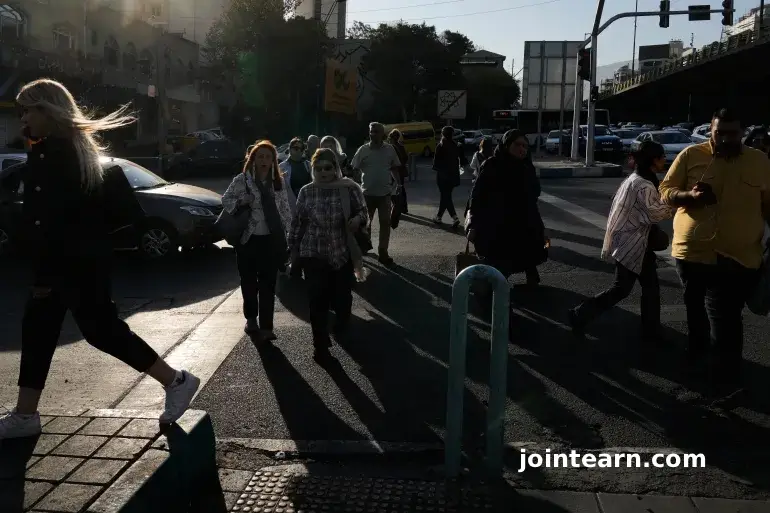
Tehran, Iran – As Iran continues to grapple with spiraling economic hardship and rising social tension following its brief but destructive war with Israel, deep divisions are emerging within the government over how to respond to the demands of Iran’s younger generations. Despite attempts at outreach, including the appointment of a so-called “Gen Z adviser,” many Iranians remain skeptical of the state’s sincerity and increasingly defiant of the country’s rigid social restrictions.
An Attempt at Youth Outreach: Meet Iran’s ‘Gen Z Adviser’
A month ago, Iranian President Masoud Pezeshkian introduced a new youth outreach initiative by appointing Amirreza Ahmadi as his adviser on Generation Z. Photos of the two smiling together went viral, but it didn’t take long for the backlash to begin.
Ahmadi, who publicly shared his mobile number to foster direct engagement, was sharply criticized online. Some users accused him of being disconnected from the experiences of actual Iranian youth — and even of using bots to inflate his social media following. These criticisms led Ahmadi to block comments on his accounts, dealing a blow to what was meant to be a showcase of Pezeshkian’s commitment to Iran’s younger citizens.
Political analysts say the attempted outreach has fallen flat because it lacks authenticity.
“The Iranian state is struggling to speak the language of a generation that grew up online and outside its ideological frame,” said Sanam Vakil, director at Chatham House’s Middle East and North Africa Programme. “Their outreach feels transactional rather than transformative.”
Youth Defiance Grows Amid Crumbling Economy
Iran’s Gen Z — a generation born into economic sanctions, social control, and political disillusionment — is driving much of the visible pushback against government policies. With inflation skyrocketing and corruption rife, many young Iranians feel they have nothing left to lose. From flouting hijab rules to dancing in public spaces and using VPNs to access banned platforms, youth-led acts of defiance are spreading.
Videos of young men and women dancing publicly — breaking the Islamic Republic’s long-standing bans on mixed-gender dancing — have exploded across Iranian social media. In one viral incident in downtown Tehran, a group of young people danced during a street music performance, resulting in the closure of a band member’s Instagram account by authorities.
“The hardline elite’s fear of losing control outweighs any concern about losing the young,” Vakil added.
Moderates Push for Reform, Hardliners Push Back
Since the end of the 12-day Iran-Israel conflict in June, some factions in the Iranian government, particularly moderates like former President Hassan Rouhani, have argued that maintaining public support is crucial to national stability. Rouhani recently criticized hardline politicians for “advancing legislation opposed by an overwhelming majority of Iranians,” likely referring to the mandatory hijab law.
The current government has stated it will not enforce Iran’s strict dress code, and the Supreme National Security Council has instructed authorities to reduce enforcement. However, morality police vans have once again been spotted across the country.
Hardliners are aggressively counteracting reformist efforts. State-affiliated news agencies boasted last week about shutting down a permitted electronic music event in Pakdasht after claims of indecent behavior. Clothing shops and restaurants have been closed for allowing dancing, wearing “improper attire,” or allegedly serving alcohol.
The government’s stance is often contradictory — with one hand loosening some restrictions to avoid unrest, and the other tightening controls to placate conservative factions like the Islamic Revolutionary Guard Corps (IRGC).
Hijab, Internet, and Motorcycles: Symbolic Acts of Resistance
The debate over the hijab, long a flashpoint in Iranian politics, has intensified since the death of Mahsa Amini in 2022. Her death in custody for alleged hijab violations sparked months of deadly protests that continue to influence the political landscape.
Today, many women openly refuse to wear the hijab in public, and some have turned to riding motorcycles — even though the state does not issue them licenses. Hundreds have been seen riding in groups in Tehran, challenging gender norms in one of the nation’s most visible acts of civil disobedience.
Online freedom is another battleground. Nearly all major social media platforms and thousands of websites remain blocked in Iran. Although President Pezeshkian vowed to lift these restrictions, the government now blames the Israel conflict for continued censorship.
“Pragmatists within the state are just offering their own frustration, which is of zero value,” said Azadeh Moaveni, author and NYU professor. “At best, they point out they won’t enforce laws that the majority opposes — but that’s not enough.”
The Future of Iran’s Social Order: Renewal or Repression?
With Iran facing reinstated United Nations sanctions, economic freefall, and persistent threats of military confrontation, internal pressures are mounting. Young Iranians, in particular, seem increasingly unwilling to tolerate a status quo of repressive governance, internet censorship, and economic despair.
The ongoing power struggle between moderates seeking reform and hardliners insisting on total control may shape the country’s future. Whether Iran moves toward a more open society or doubles down on authoritarianism could depend heavily on the voice — and actions — of its youth.


Leave a Reply